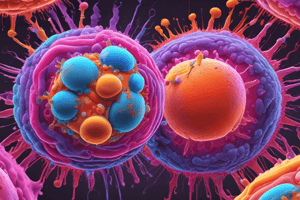Podcast
Questions and Answers
What is the primary defect seen in SCID with T-B-NK- phenotype?
What is the primary defect seen in SCID with T-B-NK- phenotype?
- Deficiency in gamma chain cytokine receptor
- Deficiency in ADA enzyme (correct)
- Impaired VDJ recombination
- MHC II defect
What causes the hypogammaglobulinemia seen in Bruton’s X-linked agammaglobulinemia?
What causes the hypogammaglobulinemia seen in Bruton’s X-linked agammaglobulinemia?
- Defective T cell signaling
- BTK signaling defect (correct)
- Deficiency in somatic hypermutation
- Mutations in CD40L
In DiGeorge Syndrome, what is the primary consequence of thymic aplasia?
In DiGeorge Syndrome, what is the primary consequence of thymic aplasia?
- Low levels of IgM
- High levels of IgE
- T cell deficiency (correct)
- B cell deficiency
Which condition is characterized by a defect in the FoxP3 gene leading to a lack of peripheral tolerance?
Which condition is characterized by a defect in the FoxP3 gene leading to a lack of peripheral tolerance?
What is the main immune defect in Chronic Granulomatous Disease (CGD)?
What is the main immune defect in Chronic Granulomatous Disease (CGD)?
Which type of leukocyte adhesion deficiency results from a defect in CD18?
Which type of leukocyte adhesion deficiency results from a defect in CD18?
What is a common clinical symptom associated with Hyper IgM Syndrome due to CD40L mutation?
What is a common clinical symptom associated with Hyper IgM Syndrome due to CD40L mutation?
Which syndrome results from a defect in both Fas and FasL leading to a failure of lymphocyte apoptosis?
Which syndrome results from a defect in both Fas and FasL leading to a failure of lymphocyte apoptosis?
How does the defect in MHC class II contribute to the symptoms of Bare Lymphocyte Syndrome type 2 (BLS-2)?
How does the defect in MHC class II contribute to the symptoms of Bare Lymphocyte Syndrome type 2 (BLS-2)?
Describe the relationship between IgA deficiency and anaphylaxis associated with IVIg treatment.
Describe the relationship between IgA deficiency and anaphylaxis associated with IVIg treatment.
What are the clinical implications of a defect in the LYST gene seen in Chediak-Higashi syndrome?
What are the clinical implications of a defect in the LYST gene seen in Chediak-Higashi syndrome?
How does Job's syndrome result in increased susceptibility to infections?
How does Job's syndrome result in increased susceptibility to infections?
What challenges arise from the absence of Tregs in IPEX syndrome?
What challenges arise from the absence of Tregs in IPEX syndrome?
Explain the main defect observed in Wiskott-Aldrich syndrome and its resultant symptoms.
Explain the main defect observed in Wiskott-Aldrich syndrome and its resultant symptoms.
What is the primary defect in Familial Hemophagocytic Lymphohistiocytosis and its effect on immune cells?
What is the primary defect in Familial Hemophagocytic Lymphohistiocytosis and its effect on immune cells?
Characterize the defects associated with the leukocyte adhesion deficiencies (LAD).
Characterize the defects associated with the leukocyte adhesion deficiencies (LAD).
Flashcards
SCID
SCID
Severe Combined Immunodeficiency, a group of primary immunodeficiencies characterized by severe T cell deficiency, often with B cell deficiency leading to susceptibility to infections.
SCID-XI
SCID-XI
X-linked SCID, a type of SCID caused by a defect in the common gamma chain, which affects cytokine receptor signaling.
ADA SCID
ADA SCID
SCID caused by a deficiency in adenosine deaminase (ADA), an enzyme crucial for purine metabolism.
RAG SCID
RAG SCID
Signup and view all the flashcards
Bare Lymphocyte Syndrome-1 (BLS-1)
Bare Lymphocyte Syndrome-1 (BLS-1)
Signup and view all the flashcards
Bare Lymphocyte Syndrome-2 (BLS-2)
Bare Lymphocyte Syndrome-2 (BLS-2)
Signup and view all the flashcards
Hyper IgM Syndrome
Hyper IgM Syndrome
Signup and view all the flashcards
Wiskott-Aldrich Syndrome
Wiskott-Aldrich Syndrome
Signup and view all the flashcards
DiGeorge Syndrome
DiGeorge Syndrome
Signup and view all the flashcards
Job's Syndrome
Job's Syndrome
Signup and view all the flashcards
Bruton's X-linked Agammaglobulinemia
Bruton's X-linked Agammaglobulinemia
Signup and view all the flashcards
Chronic Granulomatous Disease (CGD)
Chronic Granulomatous Disease (CGD)
Signup and view all the flashcards
Leukocyte Adhesion Deficiency (LAD)
Leukocyte Adhesion Deficiency (LAD)
Signup and view all the flashcards
IPEX Syndrome
IPEX Syndrome
Signup and view all the flashcards
ALPS
ALPS
Signup and view all the flashcards
APECED
APECED
Signup and view all the flashcards
SCID
SCID
Signup and view all the flashcards
SCID-XI
SCID-XI
Signup and view all the flashcards
ADA SCID
ADA SCID
Signup and view all the flashcards
RAG SCID
RAG SCID
Signup and view all the flashcards
BLS-1
BLS-1
Signup and view all the flashcards
BLS-2
BLS-2
Signup and view all the flashcards
Hyper IgM Syndrome
Hyper IgM Syndrome
Signup and view all the flashcards
Wiskott-Aldrich Syndrome
Wiskott-Aldrich Syndrome
Signup and view all the flashcards
DiGeorge Syndrome
DiGeorge Syndrome
Signup and view all the flashcards
Job's Syndrome
Job's Syndrome
Signup and view all the flashcards
Bruton's XLA
Bruton's XLA
Signup and view all the flashcards
IgA Deficiency
IgA Deficiency
Signup and view all the flashcards
Chediak-Higashi Syndrome
Chediak-Higashi Syndrome
Signup and view all the flashcards
HLH
HLH
Signup and view all the flashcards
IPEX Syndrome
IPEX Syndrome
Signup and view all the flashcards
ALPS
ALPS
Signup and view all the flashcards
APECED
APECED
Signup and view all the flashcards
Chronic Granulomatous Disease (CGD)
Chronic Granulomatous Disease (CGD)
Signup and view all the flashcards
Leukocyte Adhesion Deficiency (LAD)
Leukocyte Adhesion Deficiency (LAD)
Signup and view all the flashcards
Study Notes
Primary Immunodeficiencies
-
Severe Combined Immunodeficiency (SCID)
- SCID: Aspergillus and Candida, GI, respiratory infections - Broad range of infections affecting multiple organ systems.
- SCIDXI: Common γ chain, cytokine receptor - A common molecular factor in the receptor system is deficient.
- SCID defect T-B-NK-: ADA (purine salvage) - Adenosine deaminase deficiency prevents proper purine metabolism, leading to impaired immune function across multiple cell types.
- SCID defect T-B-NK+: RAG (no VDJ recombination but NK cells are still fine) - RAG deficiency prevents the rearrangement of variable, diversity, and joining regions of genes in lymphocytes, impacting B and T cells but not NK cells.
-
Bare Lymphocyte Syndrome (BLS)
- Pathophysiology: Defects in MHC I and II lead to impaired T-dependent humoral responses and T cell development.
- BLS-1: MHC I defect (TAP transporter), low CD4+, bacterial upper respiratory infections - Defective transport of MHC I molecules leads to decreased CD4+ T-cells and elevated susceptibility to bacterial infections.
- BLS-2: MHC II defect, low CD8+, - Defective MHC II molecules lead to decrease in CD8+ T-cells.
-
Hyper IgM Syndrome (HIGM)
- HIGM1: CD40L, X-linked - Dysfunction in the CD40 ligand, an X-linked condition.
- HIGM2: AID mutation (somatic hypermutation and class switching), hyperplastic GCs, AR - Somatic hypermutations and class switching are affected by AID mutations, leading to accumulations of proliferating germinal centers, an autosomal recessive disorder.
- HIGM3: CD40, AR - Dysfunction in the CD40 receptor, an autosomal recessive condition.
-
Wiskott-Aldrich Syndrome (WAS)
- WASP protein defect impacting cytoskeletal rearrangement in B and T cells, X-linked, eczema, thrombocytopenia, petechiae - A deficiency in WASP, an X-linked disorder, affects cytoskeletal structure affecting B and T cell functions leading to eczema, low platelets, and easy bruising.
-
DiGeorge Syndrome
- 22q11, thymic aplasia, T cell deficiency (because of no thymus!) - A chromosomal deletion leads to thymic atrophy, impacting T cell formation and function.
-
Job's/Hyper IgE Syndrome
- AD cytokine signaling defect from multiple sources, high IgE, cold abscesses, skeletal abnormalities, pneumatoceles (in lung) - Autoimmune disorders affect cytokine signaling mechanisms, leading to elevated IgE levels and various symptoms.
-
Bruton's X-linked Agammaglobulinemia (XLA)
- BTK signaling, X-linked, B cell deficiency, pre- to pro-B cell defect - Disruption in B cell signaling pathways lead to decreased B cell development.
-
IgA Deficiency
- Low IgA, other Igs normal. Mechanism unknown, anaphylactic to IVIg - Decreased levels of IgA, but other immunoglobulin types are normal, an unknown mechanism, and individuals are sensitive to intravenous immunoglobulin.
-
Chediak-Higashi Syndrome
- Partial albinism, LYST gene, no vesicle transport or fusion, low NK, defective CD8+, and phagocytes, hemophagocytic lymphohistiocytosis - A LYST gene deficiency affects vesicle transport affecting NK cells , CD8+ and phagocytes. Can lead to excessive inflammation.
-
Familial Hemophagocytic Lymphohistiocytosis (FHL)
- Perforin defect, NK and CD8+ defect - A deficiency in perforin leads to a defect in killing functions of NK and CD8+ lymphocytes.
-
IPEX (Immune dysregulation, polyendocrinopathy, enteropathy, X-linked)
- Fox3P gene, no Tregs, no peripheral tolerance - Decreased regulatory T-cells impact peripheral tolerance in immune response.
-
ALPS (Autoimmune Lymphoproliferative Syndrome)
- Fas/FasL defect, no apoptosis in either tolerance, lymphadenopathy and hepatosplenomegaly (buildup of cells that need to be dead) - Apoptosis is affected by Fas/ FasL defects, leading to a buildup of immune cells and lymphadenopathy.
-
APECED (Autoimmune Polyendocrinopathy-Candidiasis-Ectodermal Dystrophy)
- AIRE deficiency, no central tolerance in cortical thymic epithelial cells - Deficient expression of AIRE impacts central tolerance in thymic epithelial cells.
-
Chronic Granulomatous Disease (CGD)
- cp91PHOX, no respiratory burst from phagocytes, negative nitroblue tetrazolium, symptoms – infection from catalase+ organisms (because the respiratory burst is ROS), granulomas, and Aspergillus pneumonia - Impaired respiratory burst in phagocytes, leading to increased susceptibility to certain bacteria.
-
Leukocyte Adhesion Deficiencies (LAD)
- Defect in leukocyte extravasation (leukocytosis, no pus when infected)
- LAD1: CD18, low affinity integrin, no umbilical detachment - A deficiency in the CD18 protein leads to a low affinity integrin function causing delay in umbilical separation.
- LAD2: selectin - Deficient selectins in leukocyte extravasation.
- LAD3: high affinity integrin - Deficient high affinity integrins in leukocyte extravasation.
Studying That Suits You
Use AI to generate personalized quizzes and flashcards to suit your learning preferences.




